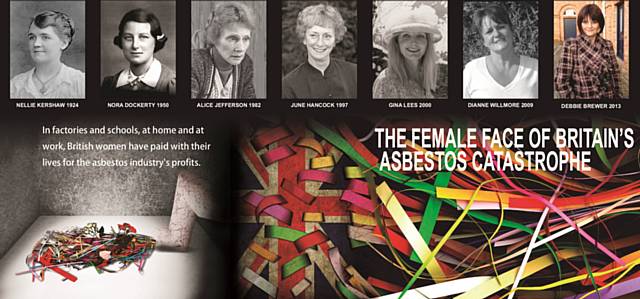Connections to Rochdale in asbestos legacy art
Date published: 03 August 2013

The digital artwork by Colombian artist Guillermo Villamizar called ‘the female face of Britain’s asbestos catastrophe’
The digital artwork by Colombian artist Guillermo Villamizar called ‘the female face of Britain’s asbestos catastrophe’, recently unveiled in Westminster that addresses Rochdale’s painful asbestos legacy, features a number of important women who were landmarks for asbestos campaigning.
Rochdale Online reported earlier this week that two of those women were Nellie Kershaw and Nora Dockerty, however, three more women with connections to Rochdale are also featured.
Nancy Tait - an asbestos campaigner who visited Rochdale's TBA factory several times in the 1970s and 80s. Back then, much to the anger of Turner & Newall, Nancy warned of the asbestos epidemic of cancer that was to hit Britain by the early 21st century. Nancy Tait was also instrumental in advising the Save Spodden Valley campaign that was founded in 2004.
Alice Jefferson was the focal point for a 1982 Yorkshire TV documentary that highly criticised the senior management of Rochdale's T&N factory and highlighted the local deaths of the asbestos cancer mesothelioma.
June Hancock was the first asbestos cancer victim to successfully sue T&N for environmental asbestos exposure. Although June's exposure to environmental asbestos occured at the JW Roberts (JWR) factory in Armley near Leeds. The parent company to JWR was T&N whose worldwide headquarters until 1948 were at the TBA site in the Spodden Valley. The corporate decisions that led to June Hancock's asbestos exposure and death some 50 years later can be directly attributed to the actions of senior directors then based in Rochdale. In the court case, T&N initially attempted to suggest there was no connection with T&N and J W Roberts - a tactic that the trial judges were highly critical of in their judgement.
To have such an important piece of international art launched in the House of Commons this month demonstrates the close connection that the Spodden Valley of Rochdale has with the legacy of asbestos disease.
What first started in Rochdale is now being witnessed throughout the world - especially as the asbestos mining and producing lobby are now concentrating their efforts on pushing their products into the developing world.
The themes of denial, obfuscation and PR spin were perfected in asbestos industry propaganda first used by PR giants Hill & Knowlton for their British corporate clients in the 1950s and 60s.
The UK headquarters for the asbestos trade lobby was an organisation called the "Asbestosis Research Council" based at T&N's Rochdale factory in the Spodden Valley. The use of a professional and authoritative "council" title for the industry lobbying body was a conceit first used by Hill & Knowlton for tobacco industry lobbying when early links to lung cancer and smoking were identified by the early 1950s.
Do you have a story for us?
Let us know by emailing news@rochdaleonline.co.uk
All contact will be treated in confidence.
Most Viewed News Stories
- 1Northern Healthcare opens supported living service in former Rochdale hotel
- 2Bombay Brew on hunt for new home as Indian street food restaurant closes with immediate effect
- 3Week of action targeting sexual predators leads to eight arrests and 21 children safeguarded
- 4Have your say on proposals for a new borough-wide Public Spaces Protection Order
- 5Rochdale man charged after teenager attacked with substance in Stockport
To contact the Rochdale Online news desk, email news@rochdaleonline.co.uk or visit our news submission page.
To get the latest news on your desktop or mobile, follow Rochdale Online on Twitter and Facebook.


